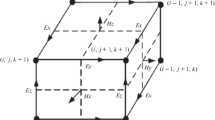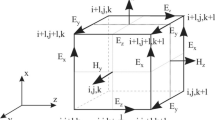Abstract
The ground penetrating radar (GPR) forward simulation all aims at the singular and regular models, such as sandwich model, round cavity, square cavity, and so on, which are comparably simple. But as to the forward of curl interface underground or “v” figure complex model, it is difficult to realize. So it is important to forward the complex geoelectricity model. This paper takes two Maxwell’s vorticity equations as departure point, makes use of the principles of Yee’s space grid model theory and the basic principle finite difference time domain method, and deduces a GPR forward system of equation of two dimensional spaces. The Mur super absorbed boundary condition is adopted to solve the super strong reflection on the interceptive boundary when there is the forward simulation. And a self-made program is used to process forward simulation to two typical geoelectricity model.
Similar content being viewed by others
References
Lambot S, Slob E C, Van B, et al. Modeling of ground-penetrating radar for accurate characterization of subsurface electric properties [J]. IEEE Transactions on Geoscience and Remote Sensing, 2004, 42(11): 2555–2568.
Guangyou F. FDTD and optimization approach to time-domain inversing problem for underground multiple objects [J]. Microwave and Optical Technology Letters, 2001, 31(5): 384–387.
Meincke P. Linear GPR inversion for lossy soil and a planar air-soil interface[J]. IEEE Transactions on Geoscience and Remote Sensing, 2001, 39(12): 2713–2721.
Kowalsky M B, Dietrich P, Teutsch G, et al. Forward modeling of ground-penetrating radar data using digitized outcrop images and multiple scenarios of water saturation[J]. Water Resources Research, 2001, 37(6): 1615–1625.
Eisen O, Wilhelms F, Nixdorf U, et al. Revealing the nature of radar reflections in ice: DEP-based FDTD forward modeling[J]. Geophysical Research Letters, 2003, 30(5): 1218–1224.
Hubbard S, Grote K. Mapping the volumetric soil water content of a California vineyard using high-frequency GPR ground wave data[J]. Society of Exploration Geophysicists, 2002, 21(6): 556–559.
Cull J, Massie D, Roberts J. Complex impedance mapping using GPR survey methods[A]. International Geoscience and Remote Sensing Symposium[C]. Toulouse: IEEE, 2003. 2909–2911.
Hasegawa Y, Yokoe K, Kawai Y, et al. GPR-based adaptive sensing GPR manipulation according to terrain configurations [A]. International Conference on Intelligent Robots and Systems [C]. Sendai: IEEE, 2004. 3021–3026.
Bergmann T, Robertsson J O A, Holliger K. Numerical properties of staggered finite-difference solutions of Maxwell’s equations for ground-penetrating radar modeling[J]. Geophysical Research Letters, 1996, 23(1): 45–48.
Carcione J M. Radiation patterns for 2-D GPR forward modeling[J]. Geophysics, 1998, 63(2): 424–430.
Bernardi P, Cavagnaro M, Atanasio P, et al.. FDTD, multiple-region/FDTD, ray-tracing/FDTD: A comparison on their applicability for human exposure evaluation [J]. International Journal of Numerical Modelling, 2002, 15(5–6): 579–593.
Rejiba F, Camerlynck C, Mechler P. FDTD-SUPMLADE simulation for ground-penetrating radar modeling [J]. Radio Science, 2003, 38(1): 511–513.
Yarovoy A G, Vazouras C N, Fikioris J G, et al. Numerical simulations of the scattered field near a statistically rough air-ground interface [J]. IEEE Transactions on Antennas and Propagation, 2004, 52(3): 780–789.
Mei K K, Fang J. Superabsorption—a method to improve absorbing boundary conditions [J]. IEEE Transactions on Antennas and Propagation, 1992, 40(9): 1001–1010.
Cui T J, Chew W C, Aydiner A A, et al. Fast-for-ward solvers for the low-frequency detection of buried dielectric objects[J]. IEEE Transactions on Geoscience and Remote Sensing, 2003, 41(9): 2026–2036.
Joaquim F G. A novel 3-D subsurface radar imaging technique[J]. IEEE Transactions on Geoscience and Remote Sensing, 2002, 40(2): 443–452.
Author information
Authors and Affiliations
Corresponding author
Additional information
Foundation item: Project (50099620) supported by the National Natural Science Foundation of China
Rights and permissions
About this article
Cite this article
Dai, Qw., Feng, Ds. & He, Js. Finite difference time domain method forward simulation of complex geoelectricity ground penetrating radar model. J Cent. South Univ. Technol. 12, 478–482 (2005). https://doi.org/10.1007/s11771-005-0186-7
Received:
Accepted:
Published:
Issue Date:
DOI: https://doi.org/10.1007/s11771-005-0186-7
Key words
- ground penetrating radar
- finite difference time domain method
- forward simulation
- ideal frequency dispersion relationship




